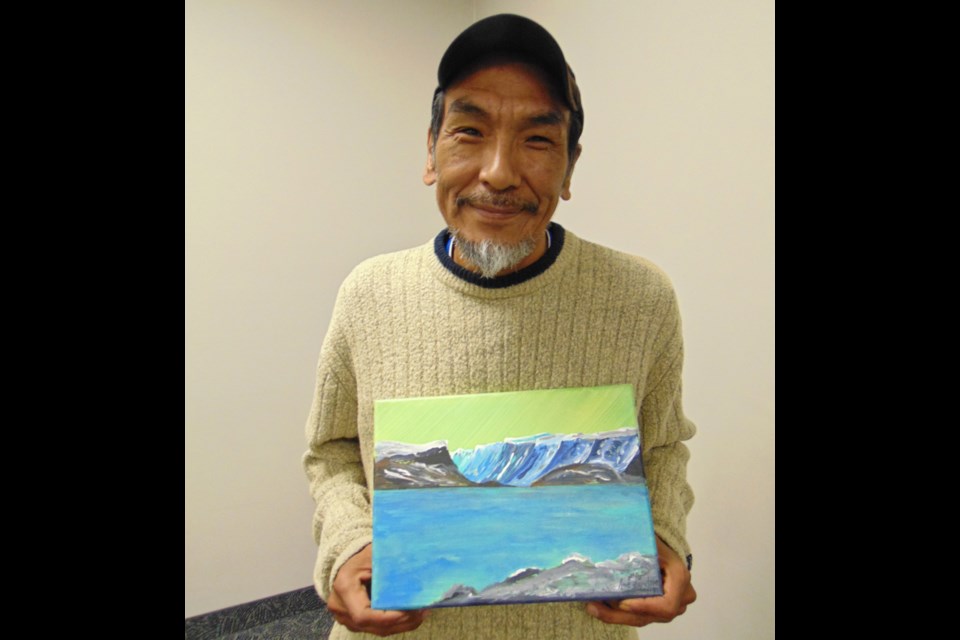If you don’t listen to your parents, the monster will get you.
This is the moral of the story in Ame Papatsie’s film, Qalupalik, an animated short film recently screened at the University of Guelph during Aboriginal Awareness Week.
The film tells the story of Qalupalik, a part-human sea monster that lives deep in the Arctic Ocean.
The monster preys on children who do not listen to their parents or elders and that is the fate of Angutii, a young boy who refuses to help in his family's camp and instead chooses to play by the shoreline.
But one day, Qalupalik seizes him and drags him away.
Angutii's father, a great hunter, must then embark on a lengthy kayak journey to try and bring his son home.
“It’s an old legend. The ancestors made this up to scare us, to make us understand how important it is to listen to our parents and elders,” Papatsie said.
Papatsie, is a local Inuit artist, chef, storyteller and illustrator of children’s books.
He is also well-known for his unique technique of drawing simultaneously with both hands in perfect symmetry.
A graduate of McGill University and Dalhousie he has designed many drawings and paintings, numerous logos, sealskin masks, murals, tattoos, and computer graphics using images from his cultural heritage.
And filmmaking, was another way Papatsie thought he could share his love of art and culture.
“I wanted to make this into a film because it’s important to me to tell these stories, to keep them alive,” Papatsie said.
Inuit peoples are rooted in their oral tradition.
For Papatise, being able to retell the old legends and traditional teachings from his Inuit elders through his art, is a gift.
“In our culture, oral communication is vital and traditional knowledge from the elders is so important. For me, sharing these traditions in art is about connecting with nature, animals and people,” he says.
Qalupalik, was made through the Nunavut Animation Lab, a joint initiative between the National Film Board of Canada and Inuit Broadcasting Corporation in association with the Banff Centre, APTN, the National Screen Institute (NSI), Nunavut Film and the Government of Nunavut.
Papatsie was born and raised in a small community, Pangnirtung on Baffin Island in Nunavut.
“Everybody up north knows me by my Inuit name, Siqiniq, but here, it’s Ame. My father’s name was Aisa and my name was Siqniq, Everybody knew me by that name. But the government didn’t know it, so they had to give us a first and last name. There was an operation called operation surname and that’s when they gave us an e-6 number. E-6 is the region of the community and 1107 was my number. It was so the government could keep track of us,” Papatsie said.
“But my parents, gave me the name Ame and Papatsie is from my grandfather. So Ame Papatsie is my given government name. It is a third-generation name, inherited from my brother. I’m known as ‘grandmother’ and I’m so proud of that.”
It was his own grandmother, also an artist, that introduced her grandson to a love for art.
Papatsie first attended school in hospitality. He completed a chef program in Fort McMurray which led to a bachelor in education.
But due to health issues, Papatsie left his career as a chef and decided to focus on what was once just a hobby, his art.
And since then, he has been an invited artist at the Nunavut Arts and Crafts Association’s annual arts festival since 2003 and was twice invited to participate in the Great Northern Arts Festival in Inuvik, where he received two awards, Most Valuable Participant and Spiritual Artist Award.
Papatsie is an active member of the arts community in Nunavut as the Chairman of the Nunavut Arts and Crafts Association and a board member for the Inuit Artists Association. He also participated in the Art Battle in Ottawa and also in the Panamania Art Battle, Toronto. Papatsie was one of six international winners.
At the film screening, Papastie was eager to share his new film, his experiences and his culture.
“Inukshuks all have different meanings such as luring caribou to the lake, a good fishing spot or don’t cross because of thin ice. Snowflakes too all have different meanings. You need to live on the land to know them all,” he said.
The purpose of Aboriginal Awareness Week at the University of Guelph is to acknowledge the First Nations, Métis, and Inuit presence and partnerships on campus to create opportunities for education and discussion.
Aboriginal Awareness Week is a collaborative initiative between the department of Student Experience, the Aboriginal Student Association and other campus groups, departments and faculty.
“Aboriginal Awareness week happens in the fall every year at the university. This year, my intention was to have as many different perspectives through the week from varying aboriginal cultures in Canada and I wanted to bring in various programs of study,” said Chelsea Brant, coordinator of aboriginal programs at the University of Guelph.
“I wanted to make sure all were represented this year and it’s amazing to have someone like Ame take part and share his own personal experiences with us.”
Papatsie has been residing in Guelph for over four years.
“I lived in Toronto, but I was feeling an ‘art block.’ Friends and other artists brought me to Guelph,” Papatsie said.
Today, with a love for children and a passion for art, Papatsie continues to teach art at Holy Trinity Secondary Catholic School in Oakville.
“It’s so important for me to have the Inuit culture known,” Papatsie said.
“I love that I can do that here, to be able to share them here.”

.png;w=120;h=80;mode=crop)

